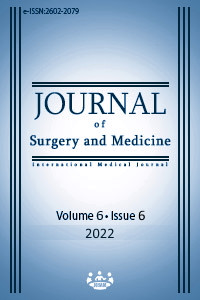Oromandibular dystonia seen during pramipexole treatment: A rare case
Keywords:
Oromandibular dystonia, Pramipexole, Dopamine agonist, Restless leg syndromeAbstract
Downloads
References
Slaim L, Cohen M, Klap P, Vidailhet M, Perrin A, Brasnu D, et al. Oromandibular dystonia: demographics and clinical data from 240 patients. J Mov Disord. 2018;11:78.
Albanese A, Bhatia K, Bressman SB, DeLong MR, Fahn S, Fung VS, et al. Phenomenology and classification of dystonia: a consensus update. Mov Disord. 2013;28:863-73.
Lee KH. Oromandibular dystonia. Oral Surg Oral Med Oral Pathol Oral Radiol Endod. 2007;104:491-6.
Epidemiological Study of Dystonia in Europe (ESDE) Collaborative Group. A prevalence study of primary dystonia in eight European countries. J Neurol. 2000;247:787-92.
Papapetropoulos S, Singer C. Eating dysfunction associated with oromandibular dystonia: clinical characteristics and treatment considerations. Head & Face Medicine. 2006;2:47.
Pandey S, Jain S. Pramipexole-associated fixed limb dystonia in Parkinson's disease. Parkinsonism Relat Disord. 2016;31:159-60.
Feyder M, Bonito Oliva A, Fisone G. L-DOPA-induced dyskinesia and abnormal signaling in striatal medium spiny neurons: focus on dopamine D1 receptor-mediated transmission. Front Behav Neurosci. 2011;5:71.
Fiorentini C, Busi C, Gorruso E, Gotti C, Spano P, Missale C. Reciprocal regulation of dopamine D1 and D3 receptor function and trafficking by heterodimerization. Mol Pharmacol. 2008;74:59-69.
Quinn N. Disproportionate antecollis in multiple system atrophy. Lancet. 1989;1:844.
Doherty KM, van de Warrenburg BP, Peralta MC, Silveira-Moriyama L, Azulay J-P, Gershanik OS, et al. Postural deformities in Parkinson's disease. Lancet Neurol. 2011;10:538-49.
Iijima M, Osawa M, Uchiyama S, Kitagawa K. Pramipexole-induced antecollis in patients with Parkinson's disease: Two cases and literature review. eNeurologicalSci. 2015;1:21-3.
Pfeiffer RF, LeDoux MS. Levodopa-induced lateral jaw deviation dystonia. Parkinsonism Relat Disord. 2015;21:808.
Weiner WJ, Nausieda PA. Meige's syndrome during long-term dopaminergic therapy in Parkinson's disease. Arch Neurol. 1982;39:451-2.
Tan EK, Chan LL, Wong MC. Levodopa-induced oromandibular dystonia in progressive supranuclear palsy. Clin Neurol Neurosurg. 2003;105:132-4.
Kidron D, Melamed E. Forms of dystonia in patients with Parkinson's disease. Neurology. 1987;37:1009-11.
Downloads
- 520 699
Published
Issue
Section
How to Cite
License
Copyright (c) 2022 Fatma Kara, Mehmet Fatih Göl, Ayhan Varlıbaş
This work is licensed under a Creative Commons Attribution-NonCommercial-NoDerivatives 4.0 International License.
















